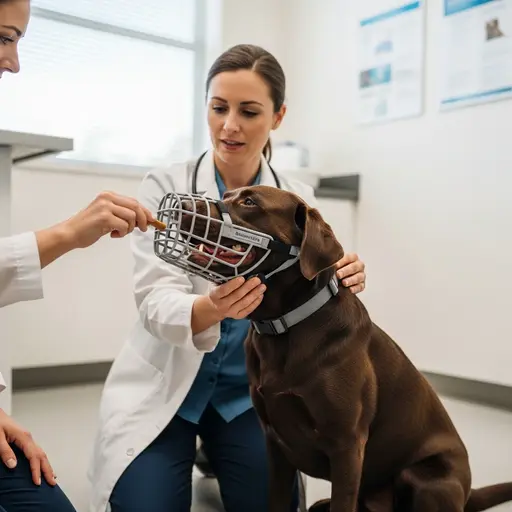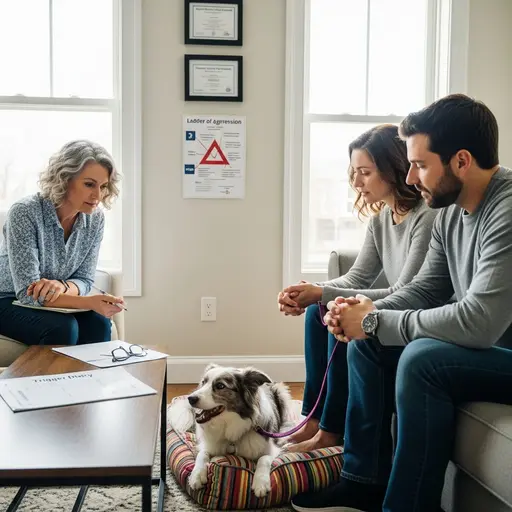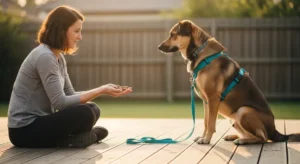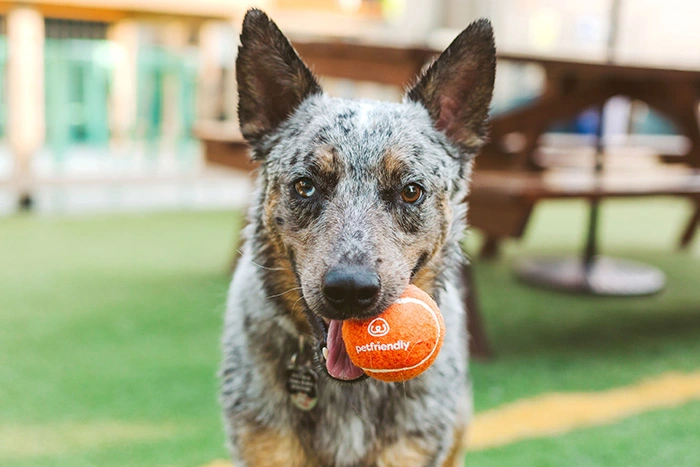Dog aggression issues stem from fear, territorial behavior, frustration, or learned responses that can escalate without intervention. Professional assessment and consistent, positive reinforcement training are essential for managing these behaviors safely and humanely.
Early intervention prevents escalation and keeps families safe. This comprehensive guide covers root causes, warning signs, proven treatment strategies, and practical tools to help you and your dog build a more peaceful life together.
What Are Dog Aggression Issues?
Dog aggression issues refer to threatening behaviors directed toward people, other animals, or objects. These behaviors exist on a spectrum—from subtle warnings like stiffening to overt actions like biting. Understanding that aggression is a symptom, not a personality trait, is critical.
Types of Aggression in Dogs
1. Fear-Based Aggression
The most common form. A scared dog learns that growling or snapping makes scary things back away. This creates a feedback loop: the dog feels relief, so the behavior strengthens.
2. Territorial/Protective Aggression
Dogs guard resources, spaces, or family members. The mail carrier leaves when the dog barks—reinforcing the behavior.
3. Frustration-Elicited Aggression
Leash-reactive dogs are classic examples. They want to greet another dog but can’t, so frustration boils over into lunging and barking.
4. Pain-Related Aggression
Even gentle dogs may snap when hurt. Arthritis, dental disease, or hidden injuries commonly trigger this.
5. Predatory Aggression
Less common in pets but dangerous. Involves silent stalking and biting without warning signals.
6. Social/Dominance Aggression
Misunderstood and over-diagnosed. True status-related aggression is rare and requires expert evaluation.
The “Ladder of Aggression”
Dogs rarely bite without warning. They climb a ladder of escalating signals:
- Lip licking, yawning
- Turning the head away
- Stiffening, hard stare
- Growling, showing teeth
- Snapping
- Biting
Early rungs are appeasement signals. When ignored, dogs climb higher. Most owners miss these until the dog reaches growling.

Common Causes Behind Dog Aggression Issues
Understanding triggers is half the battle. No dog is “born mean.”
Genetic Predisposition
Some lines have lower aggression thresholds. Herding breeds may nip; guard breeds may be territorial. This isn’t destiny—it’s information that shapes training approaches.
Lack of Early Socialization
Puppies have critical windows (3-14 weeks) during which positive experiences shape their lifelong confidence. Missed opportunities create fearful adults.
Traumatic Experiences
A single attack by another dog, harsh punishment, or frightening incident can imprint lasting reactivity.
Medical Conditions
Thyroid imbalances, brain tumors, and chronic pain dramatically increase irritability. Always rule out medical causes first.
Inconsistent Leadership
Mixed messages confuse dogs. If jumping is cute sometimes but corrected other times, dogs can’t predict outcomes, creating anxiety-based aggression.
Over-Correction
Punishing growls teach dogs to skip warnings and bite directly. A growl is communication; suppressing it removes the yellow traffic light.
Recognizing Early Warning Signs
Catching aggression issues early makes treatment 3x more effective, according to veterinary behaviorists. Watch for these subtle cues:
Body Language Red Flags
- Whale eye (showing whites of eyes)
- Freezing mid-action
- Piloerection (hackles up)
- Displacement behaviors: sudden sniffing, scratching when nothing is there
- Closed mouth when normally relaxed
Contextual Clues
- Resource guarding: hovering over the food bowl, stealing items, and running
- Leash reactivity: fixating on triggers, vocalizing before seeing them
- Sleep startle: reacting aggressively when disturbed while resting
- Touch sensitivity: flinching at collar grabs or paw handling
Pro Tip: Keep a “trigger diary” for one week. Note time, location, trigger, dog’s body language, and outcome. Patterns emerge within days.
Immediate Steps to Take When Aggression Occurs
Your response in the moment matters. Here’s the protocol:
1. Stay Safe First
- Never put your body between fighting dogs
- Use barriers (baby gates, doors) to separate
- If necessary, use a loud noise (air horn) to startle, then separate
- Seek medical attention for any bite that breaks skin—they’re prone to infection
2. De-escalate, Don’t Punish
Yelling or physical correction adds fuel. Instead:
- Remove the trigger (person, dog, object)
- Create space: lead your dog away calmly
- Offer a safe zone: crate or quiet room—not as punishment, but as relief
3. Preserve the Scene
Take photos of the environment. What was the dog doing before? Where was everyone positioned? This data helps professionals.
4. Implement a 72-Hour Management Plan
- Leash on in the house for immediate control
- Supervise all interactions with triggers
- Avoid all known triggers for three days to reset stress hormones

Long-Term Management Strategies
Managing dog aggression issues is like managing diabetes—it’s lifelong, not “cured.” Success means reducing frequency and intensity.
The “Management First” Rule
You cannot train a dog that’s over-threshold. Management prevents rehearsal of bad behavior while you train.
| Management Tool | Best For | Why It Works |
|---|---|---|
| Baby gates | Resource guarding, multi-dog households | Creates physical barriers without isolation |
| Muzzle training | All aggression types | Gives freedom safely; reduces owner anxiety |
| Window film | Territorial barking | Blocks visual triggers that cause arousal |
| White noise machines | Sound reactivity | Masks outside noises that spark reactions |
Environmental Enrichment
Bored, under-stimulated dogs have lower frustration tolerance:
- Scent work: Hide treats around the house; 10 minutes of sniffing equals 30 minutes of walking
- Food puzzles: Slow feeding reduces resource guarding risk by teaching patience
- Safe chews: Bully sticks or frozen Kongs provide outlets for stress
The 50-Foot Rule
For reactive dogs, maintain 50 feet from triggers during training. Distance is your friend. You can always decrease it as skills improve.
Training Techniques That Work
Forget outdated “alpha” methods. Modern, science-based approaches yield lasting results.
Counter-Conditioning: Change the Emotional Response
Goal: Trigger predicts awesome things, not fear.
Protocol:
- Identify trigger (e.g., men with hats)
- Find the distance where the dog notices but doesn’t react (sub-threshold)
- Present trigger at that distance
- Immediately feed a high-value treat (chicken, cheese)
- Trigger leaves, treats stop
- Repeat 10-15 times per session
Key: Trigger must predict treat, not the other way around. Timing matters—treat within 0.5 seconds of trigger appearance.
The “Look at That” Game
Teaches dogs to voluntarily check in with you when triggered.
- When the dog sees the trigger, mark (“Yes!” or click)
- The dog looks back at you for a treat
- Builds automatic behavior: “See scary thing, look at parent for reward”
This transfers focus from trigger to handler.
Protocol for Resource Guarding
Trade, don’t take. Approach the dog with a higher-value item, toss it 6 feet away. While the dog leaves the resource, pick it up. A dog learns that your approach predicts better things.
Never: Forcefully remove items. This teaches dogs to guard more intensely.
Impulse Control Exercises
Build frustration tolerance:
- Wait at doors: Dog must sit/stay before exiting
- Leave it: Teach with low-value items first
- Place command: Dog stays on mat while you eat; builds self-control
Tools and Products That Help
The right equipment supports training but doesn’t replace it. Here’s what actually works and why:
Head Halters: Control, Not Correction
Product Type: Gentle Leader, Halti
Why It Helps: Gives control of the dog’s head direction, redirecting focus from triggers. Less aversive than choke chains; it operates on the principle that where the head goes, the body follows.
Best For: Large, strong dogs with reactivity issues. Must be introduced with positive associations (treats for wearing).
Front-Clip Harnesses
Product Type: Freedom No-Pull, Blue-9 Balance
Why It Helps: When the dog lunges, the harness gently turns them toward you, interrupting the forward motion and allowing you to regain control.
Limitation: Doesn’t address emotional state; used with training, not instead of it.
Muzzles: The Most Misunderstood Tool
Product Type: Baskerville Ultra Basket Muzzle
Why It Helps: Allows panting, drinking, and treat-taking while preventing bites. Reduces owner anxiety, which dogs sense. A calm owner is a better trainer.
Introduction Protocol:
- Show muzzle, treat
- Touch nose to muzzle, treat
- Hold muzzle with straps, treat through muzzle
- Secure for 3 seconds, remove, treat
- Build duration over 2 weeks
Calming Supplements: Adjunct, Not Cure
Product Type: Zylkene (casein protein), Solliquin (l-theanine)
Why They Help: Take the edge off anxiety, making dogs more receptive to training. Think of them as “glasses for the brain”—they clarify thinking but don’t replace learning.
Note: Always consult your vet. Effects take 3-6 weeks.
Interactive Feeders
Product Type: Outward Hound Fun Feeder, West Paw Toppl
Why It Helps: Slows eating, extends mealtime to 15-20 minutes of calm, focused activity. Reduces resource guarding by teaching patience and that food appears predictably.
When to Seek Professional Help
DIY has limits. Professional intervention is non-negotiable in these scenarios:
Red Flag Scenarios
- Bite level 3+ (punctures deeper than half the canine length)
- Bites multiple family members
- Sudden onset with no clear trigger (medical emergency)
- Aggression toward children (zero tolerance policy)
- You’ve tried training for 8+ weeks with no improvement
Who to Call: Hierarchy of Experts
1. Certified Applied Animal Behaviorist (CAAB) or Veterinary Behaviorist
- Gold standard: PhD or DVM with a behavior specialty
- Can diagnose and prescribe medication if needed
- Cost: $300-500 initial consult, but worth it for severe cases
2. Force-Free Certified Trainer
- Look for CPDT-KA, KPA-CTP, or IAABC certifications
- Must use positive reinforcement; avoid trainers guaranteeing fixes
- Cost: $100-150 per session
3. Your Veterinarian
- First stop for sudden aggression
- Can rule out pain, thyroid issues, and neurological problems
- May refer to a veterinary behaviorist
What to Avoid: Trainers who talk about “dominance,” use alpha rolls, or promise quick fixes. Aggression issues take months to resolve, not days.
Prevention: Stopping Issues Before They Start
An ounce of prevention truly equals a pound of cure.
Puppy Socialization Done Right
- Quality over quantity: One positive 10-minute experience beats an hour of overwhelm
- Body handling: Touch paws, ears, and mouth daily with treats
- Sound desensitization: Play thunder/fireworks sounds at low volume during meals
- Gentle restraint: Practice light holds that end with treats
The Rule of 7s
By 16 weeks, puppies should have experienced:
- 7 different floor surfaces
- 7 different people (including kids, men with beards, people with hats)
- 7 different locations
- 7 different types of handling
Adult Dog Maintenance
Even well-adjusted adults need ongoing work:
- Monthly novelty: Visit a new park, meet one new person
- Reinforce calm: Reward relaxed behavior during daily life
- Health checks: Annual exams catch pain early
Spay/Neuter Timing Evidence
Early spay/neuter (before 6 months) increases fear-based aggression in some breeds. Discuss optimal timing with your vet based on breed and risk factors.

Living With a Dog With Aggression Issues
Management is forever, but life can be joyful. Here’s how families make it work:
The “Two-Door” Rule
Always have two barriers between your dog and the outside world (e.g., leash + front door, crate + baby gate). Prevents door-dashing and unexpected encounters.
Building a Support System
- Inform guests: Use a “dog in training” sign on your door
- Educate children: Teach them to be statues if approached
- Connect online: Facebook groups like “Reactivedogs” offer a community
Tracking Progress
Use a 1-5 scale weekly:
- Trigger present, no reaction
- Notices trigger, orients to the handler
- Stiffens, but responds to the cue
- Vocalizes, but can be interrupted
- Full reaction (lunging, growling)
Celebrate small wins: moving from level 4 to 3 is huge progress.
The Realistic Timeline
Expect noticeable improvement in 8-12 weeks with consistent training. Plateaus are normal. Setbacks happen. Progress isn’t linear, but the trend should be upward over 3 months.
Frequently Asked Questions
Can aggressive dogs be “cured”?
No, but they can be managed to live safely. Think of it as remission, not a cure. With lifelong management, many dogs become reliable, happy companions.
Should I punish my dog for growling?
Never. Punishing growls suppresses warnings, leading to dogs who bite without warning. Thank your dog for communicating and remove the trigger.
Are some breeds more prone to aggression issues?
Genetics influence temperament, but environment shapes expression. Any breed can develop aggression. Pit Bulls aren’t inherently aggressive; Chihuahuas aren’t inherently safe. Judge the individual dog.
How much will professional help cost?
Plan for $1,500-3,000 for a severe case over 6 months. This includes behaviorist consults, follow-ups, and equipment. While expensive, it’s less than a lawsuit from a bite incident.
Will medication make my dog a “zombie”?
Veterinary behaviorists start with low doses. The goal is to reduce anxiety enough for learning to occur, not sedation. Most owners report their dog seems “more themselves” on medication.
Conclusion
Dog aggression issues are complex but solvable problems rooted in fear, pain, or frustration—not malice. The path forward combines management to prevent rehearsal, training to change emotional responses, and compassion for a dog who’s struggling.
Start today by:
- Scheduling a vet visit to rule out medical causes
- Beginning a trigger diary to identify patterns
- Muzzle training as a safety net and confidence booster
- Finding a qualified force-free trainer for personalized guidance
Remember: your dog isn’t giving you a hard time—they’re having a hard time. With patience, science-based methods, and the right support, most families see dramatic improvement within months.






